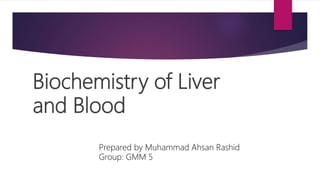
Biochemistry of liver and blood
- 1. Biochemistry of Liver and Blood Prepared by Muhammad Ahsan Rashid Group: GMM 5
- 3. Plasma Plasma Contains: 91% of water Proteins (albumin, globulin, and fibrinogen) Albumin: responsible for osmotic pressure. Globulin: alpha, beta , gamma produces antibodies. Fibrinogen: responsible for coagulation of blood.
- 5. Blood Cells The blood cells are of three types : Red Blood cells White Blood cells Platelets Hemoglobin: It is a pigment carry oxygen. The hemoglobin content of body 15g per 100ml
- 6. Red Blood Cells These are also known as “Erythrocytes” The life span of RBS is 120 days. Volume: 5-5.5 ml/mm3 The function of RBC is to carry oxygen and collect carbon dioxide through use of hemoglobin(iron) . They are of Bioconcave disc shaped No nucleus present in these cells.
- 8. White Blood Cells These are also known as “Leucocytes” The life span of WBS is 3-5days. Volume: 5000-10,000ml/mm3 The function of WBC is to provide immunity to body. They are of irregular shape Nucleus present in these cells.
- 10. TYPES of WBC They are colorless cells containing a nucleus. They are larger in size than RBC. They are divided into two called Granulocytes(They have granules in cytoplasm.) Agranulocytes(They do not have granules cytoplasm)
- 13. Platelets These are also known as “Thrombocytes” The life span of platelets are 5-9 days. Volume: 2.5 lakhs-4 lakhs. The function of platelets is to help in formation of blood clots immunity to body. They are of irregular shape Nucleus is present in these cells.
- 14. Contd. Thrombocytophenia: condition in which there is a decrease in platelet count. Clotting of Blood. It is a defense mechanism and prevents loss of blood from site of injury. Stages Prothrombin Thromboplastin : convert prothrombin into thrombin. Thrombin: fibrinogen to fibrin.
- 16. FACTS % of hemoglobin in male: 14-16g/100cc female: 12-14g/100cc Rate of breathing: 16-20 per/ minute. Volume of blood in human body: 5-6 liters. Ph level of blood: 7.4 Spleen is known as blood bank and graveyard of RBC. AB blood group: Universal reciever O blood group: Universal donar.
- 17. Disorders of Blood. Anemia: There is decrease in hemoglobin(iron content) Hemolytic: increase destruction of RBC. Leucopenia: decrease number of WBC. Erythropoiesis: Process by which RBC is formed. Vitamin B12 and folic acid is essential for development of RBC. SIZE WBC>RBC>Platelets.
- 22. Liver’s functions Liver is a main organ which is responsible for dividing of nutritional substances in our organism (for example, glucose, triacylglicerides and ketone bodies). Hepatocytes synthesizes as lot of blood plasma proteins and lipoproteins, low-weight bioactive substances (creatin, 25-oxicalciferol, hem), cholesterol. Synthesis of urea (final product of nitrogen metabolism) also takes place in the liver. Liver synthesizes bile acids and excrete a bile into intestinal tract. This process plays a very important role in lipids digestion and excretion of cholesterin and some products of metabolism into intestine. Liver play a big desintoxification role, inactivates endogenic and exogenic substances (drugs, some hormones, different toxins). Liver is a depo for iron, some another metals, vitamines A, D, E, B12, folic acid.
- 25. Role of the liver in carbohydrate metabolism. From intestine glucose pass into the liver, where most part of it undergone the phosphorillation. Glucose-6-phosphate formed in result of this reaction, which catalyzed by two enzymes – hexokinase and glucokinase. Glucose-6-phosphate is a key product of carbohydrates metabolism. In the liver this substance can metabolized into different ways depend of liver’s and whole organism’s necessity.
- 27. • Synthesis of glycogen. Content in the liver – 70-100g • Glucose-6-phosphatase catalize dephosphorillation of glucose-6-phosphate and formation of free glucose • Excess of glucose-6-phosphate, which not used for synthesis of glycogen will follow to form free glucose • Glucose-6-phosphate decomposed to H2O and CO2, and free energy for hepatocytes formed. • Part of glucose-6-phosphate oxidized in pentosophosphate cycle. • Hepatocytes content full set of gluconeogenesis necessary enzymes. So, in liver glucose can be formed from lactate, pyruvate, amino acids, glycerol. • Gluconegenesis from lactate takes place during intensive muscular work. Lactate formed from glucose in muscles, transported to the liver, new glucose formed and transported to the muscles
- 28. Role of the liver in lipid metabolism In the liver all processes of lipid metabolism take place. Most important of them are following: Lipogenesis (synthesis of fatty acids and lipids). Substrate for this process – acetyl-CoA, formed from glucose and amino acids, which are not used for another purposes Liver more active than another tissues synthesizes saturated and monounsaturated fatty acids. Fatty acids then used for synthesis of lipids, phospholipids, cholesterol ethers. Liver play a central role in synthesis of cholesterin, because near 80 % of its amount is synthesized there. Biosynthesis of cholesterin regulated by negative feedback. When the level of cholesterin in the meal increases, synthesis in liver decreases, and back to front. Besides synthesis regulated by insulin and glucagon. Liver is a place of ketone bodies synthesis. These substances formed from fatty acids after their oxidation, and from liver transported to another tissues, first of all to the heart, muscles, kidneys and brain
- 32. Role of the liver in protein metabolism Liver has full set of enzymes, which are necessary for amino acids metabolism. Amino acids from food used in the liver for following pathways: 1. Protein synthesis. 2. Decomposition for the final products. 3. Transformation to the carbohydrates and lipids. 4. Interaction between amino acids. 5. Transformation to the different substances with amino group. 6. Release to the blood and transport to another organs and tissues.
- 33. Liver synthesizes 100 % of albumins, 90 % of α1-globulines, 75 % of α2- globulines, 50 % of βglobulins, blood clotting factors, fibrinogen, protein part of blood lipoproteins, such enzyme as cholinesterase. Liver can synthesize non-essential amino acids. Liver synthesizes purine and pyrimidine nucleotides, hem, creatine, nicotinic acid, choline, carnitine, polyamines.
- 34. Thank you